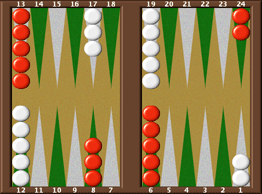There are two major things you should know about
opening moves:
- The experts, having studied opening moves for many years, and having had the benefit of experience, the use of computer programs, and tremendous personal skill and intuition, have virtually all agreed on what are the best opening moves for every possible dice combination.
- If you make any move other than what the experts recommend, you are reducing your odds of winning the game and match.
Itís as simple as that. You must simply memorize the best opening moves, and do them. Yes, it will help you greatly to also understand the reasoning for each move, and it will help you to also go to the next step and know and understand what the experts recommend you do on the
next roll in response to opening moves if your opponent gets the opening roll. And yes, none of that will be of much help unless you understand how to play the rest of the game.
But since you cannot possibly learn the entire theory of how to become a backgammon expert from a single article, let me offer some help about the opening moves.

The Big Five
There is no question what to do with
 , ,
 , ,
 , and , and
 . How to play these opening moves has been agreed to and proven to be correct for many years, and the correct plays are correct for any match score, whether you are winning or losing by a little or a lot, or tied. For all other moves, there is some debate; there are some different plays depending on the score; and the decision is not so clear. . How to play these opening moves has been agreed to and proven to be correct for many years, and the correct plays are correct for any match score, whether you are winning or losing by a little or a lot, or tied. For all other moves, there is some debate; there are some different plays depending on the score; and the decision is not so clear.
Letís take care of the sure ones first. With  you
make your five-point. Not only do most experts agree that the five-point is the most important point to make (for many reasons), but any other you
make your five-point. Not only do most experts agree that the five-point is the most important point to make (for many reasons), but any other  play puts you at an unnecessary risk of getting hit. Why is getting hit so bad, especially early in the game? Because one of the overriding principles of backgammon is that every game, no matter how complex, ends up as a
race to see who can get his checkers around the board and off first. Everything else that happens between the first roll and the removal of the last checker is just preparation for who the one is that gets to remove that last checker. Even games that end as a result of a double/drop are because the dropper determined that he is less likely to be the one removing that last checker first. play puts you at an unnecessary risk of getting hit. Why is getting hit so bad, especially early in the game? Because one of the overriding principles of backgammon is that every game, no matter how complex, ends up as a
race to see who can get his checkers around the board and off first. Everything else that happens between the first roll and the removal of the last checker is just preparation for who the one is that gets to remove that last checker. Even games that end as a result of a double/drop are because the dropper determined that he is less likely to be the one removing that last checker first.
With  you make your bar-point (seven-point) as that is the second most important point, and again, any other move leaves exposed blots (single checkers on a point). With you make your bar-point (seven-point) as that is the second most important point, and again, any other move leaves exposed blots (single checkers on a point). With  you make your four-point because that is also an important point, and again, you donít want to leave blots. And with you make your four-point because that is also an important point, and again, you donít want to leave blots. And with  you simply run a back checker all the way because it is very good for the race and, again, you leave no exposed blots. you simply run a back checker all the way because it is very good for the race and, again, you leave no exposed blots.
There used to be much debate about how to play an opening  . Many experts in the 70ís and 80ís believed that making the three-point was wrong. That they were better off making several other moves that provided them with more
flexibility and put there checkers in better strategic places for the next move. The problem with the other moves, however, is twofold: first, it leaves exposed blots, and if hit, gives the opponent an immediate advantage; and second, an opportunity to make the three-point has been passed up, and the three-point, while not as critical as the bar, five, and four-points, is still a good point to have. The experts of the new millennium virtually all agree that it is right to make the three-point with your . Many experts in the 70ís and 80ís believed that making the three-point was wrong. That they were better off making several other moves that provided them with more
flexibility and put there checkers in better strategic places for the next move. The problem with the other moves, however, is twofold: first, it leaves exposed blots, and if hit, gives the opponent an immediate advantage; and second, an opportunity to make the three-point has been passed up, and the three-point, while not as critical as the bar, five, and four-points, is still a good point to have. The experts of the new millennium virtually all agree that it is right to make the three-point with your  , regardless of the score. , regardless of the score.
And the Rest
Now, lets simply go through the list of what is the preferred play, and reasonable variations.
  |
Run a back checker. |
  |
There are three acceptable plays. You can make your two-point; you can run a back checker all the way out to your 14-point; you can run a back checker out to your opponentís bar-point (24/18), and then bring down one checker off your mid-point (13/9). |
  |
There are two plays: You can either run a checker all the way off your 24-point, or you can run to your opponentís bar-point and bring one down from your mid-point. |
  |
Two plays: Run all the way, or run to the bar and bring one down.
|
  |
Make your bar-point. |
  |
Two plays: Move a back checker up (24/20) and bring one down (13/8), or bring two down from the mid-point (13/8, 13/9). |
  |
Make your three-point. |
  |
Two plays: Move a back checker two spaces (24/22) and bring one down (13/8), or bring two checkers down (13/8, 13/11). |
  |
Generally, it is right to split the back checker and bring one down (24/23, 13/8). When behind in the match and a gammon win is a major plus, you might bring one down and slot your five-point (13/8, 6/5). |
  |
This move has the most possible variation, depending on score, but generally the experts agree that it is best to move up three off your back point (24/21) and bring the four down from the mid-point (13/9). |
  |
Make your four-point. |
  |
Generally, it is right to split the back checker and bring one down (24/23, 13/9), but it is not a bad gambling play, when gammons are key, to bring one down and slot your five-point.
|
  |
This play also has many variations, but generally the experts agree that the best play is to bring your back checker up three (24/21) and bring a two down from the mid-point (13/11). |
  |
Make your five-point. |
  |
Bring down a checker (13/11) and slot your five-point. It was right to split your back checkers until recently, when modern computer rollouts showed that slotting is usually better, but you can vary this depending on the match score. |
Winning More Often
Will you win more often if you make the above opening moves? Yes, absolutely. It has been proven, statistically. Now, with the computer programs
(Snowie and
Jellyfish and
Gnu BG) we can take any move or position and play out thousands, and even millions of games to prove that over the long run, one play or cube decision is better than another.
So, not only for opening moves, but for every move, if you want to win more often, you must learn the correct move. It is impossible to memorize the correct move for every possible position, but it certainly is possible to memorize the opening moves. So, as long as youíve got the list, why not do it?
|

